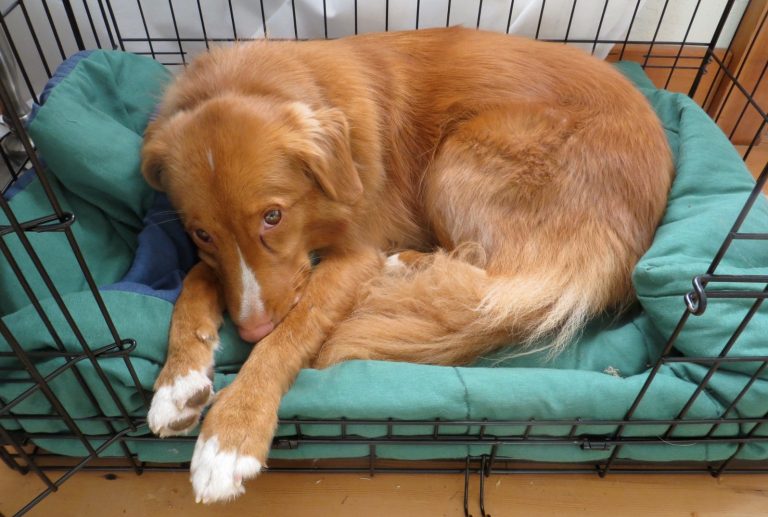House training can take forever without a crate. Dogs are highly social animals, and they should be indoors when you are not home or when you sleep and cannot interact with them. This is where the crate helps. It also allows you to predict behaviors. For example, you let the dog out of the crate for playtime and toilet.
A crate allows you to leave your dog alone in the home when you are away. If your pup spends a lot of time alone at home, a crate prevents destructive behavior and problems in the home.
What is the ideal confinement area?
We have to make the distinction between crate and confinement area. When we talk about crate training process, we do not suggest putting your dog in a small cage where he cannot move or do anything.
Nope, we recommend crate training in a confinement area where your dog has space.
The ideal confinement area when dog is alone is a bed and sleeping area at one end, a toilet at the other (if your dog cannot hold it), fresh water bowl, and a stuffed chew toy inside.
Add substrate if your dog spends too much time alone and cannot hold it. But the problem with this is the home might smell of urine. So, change the diaper/substrate as often as possible to prevent any urine scent in the home.
Should You Try it?
Some dog owners might feel guilty for crate training their puppy. They think enclosed spaces can create a shelter-like environment for the dog where it is scary. But the reality is that this confinement area creates a safe place for your dog to rest and relax.
Dogs instinctively seek small spaces to create their own protective shelter. Crates are also useful puppy training tools.
Veterinarians, dog trainers, and dog breeders recommend crate training from a young age. It is an essential part of housebreaking puppies.
You never know what is going to happen in the future. If you crate train your young puppy, you can be ready for the future. Imagine another quarantine due to Covid-19, and your adult dog has to stay home with you for days?
Benefits of Crate Training
Crate training has benefits for both you and your pet. When correctly and humanely used, it has many advantages. Here are some of them.
- You can enjoy peace of mind when leaving your pup home alone. You know nothing can be soiled or destroyed
- Crate training helps you with potty training by using the confinement to encourage control and establish a regular toilet routine
- You can travel with your dog safely when he is already accustomed to a crate
- Your dog enjoys the privacy and security of his own den where he can retreat when tired, stressed, or not feeling well
- Helps with separation anxiety when you are not at home
- Your dog can learn to control its bowels and associate elimination only with the outdoors
- Crate helps your dog to be more conveniently included in family outings and trips when you have to travel
How to teach your dog to love the crate?
A crate or a confinement area gives your pup a safe space and a state of mind where he can just relax and enjoy his alone time.
But it is not easy to teach a dog to love the crate or confinement area. Dogs are naturally suspicious and anxious when they need to enter an enclosed space.
So, what can you do? Well, the simple trick is to make the confinement area as fun and as entertaining as possible. You need to create a positive association with the crate.
Some owners make the mistake of buying a crate, putting the dog inside, and going out instantly. Wrong. You cannot go from a dog who doesn’t want to be alone to a dog who stays comfortably alone in a crate overnight.
Dogs love crates when you teach them to do. Start by leaving the crate door of the confinement area open. Introduce it to your new puppy.
Put a piece of kibble inside. Let your dog sniff it and wait for him to get inside. Do not lock him. Leave the door open and have the dog enter, grab the kibble, and then get out if necessary.
Another technique you can use is to close the crate, but have some kibble inside. This will give your dog an association that they need to do something in order to get the kibble and get into the amazing place where there is food. Wait for your dog to start asking to get inside, open the crate door, and leave it open. You have now created a desire for your dog to want to get inside.
Toss a couple of more treats inside. Wait for your dog to get them, but do not leave the door. This is the most important part of crate training. Your dog should understand they can get in and out anytime. Your goal is to make your dog love spending time inside. When there are treats involved, it instantly teaches your dog it is a good place to be.
Now comes the next step. This is when you want your dog to earn its crate time. When dogs work for rewards and toys, they feel more accomplished and happy. Same thing with dinner. If you just put a bowl of food before your dog, he might eat it. But he will feel more accomplished if you hand feed while practicing simple commands.
To make your dog earn his crate time, lock the door while he is outside. Wait until your dog sits calmly before the crate and shows signs that he wants to get in. Open the door and let him inside.
Now what you need to understand is that dogs are not scared or anxious because of the crate. They are scared of being locked in. So, wait until you close the door for a while.
Mark every time when your dog enters the crate. You can use praise like good boy or give him more treats when he goes inside. Or use a clicker.
Your dog will eventually learn the crate is a nice place to be. Just leave the door open and your dog will go inside every now and then. For the first few days or weeks (depending on how the dog is progressing), do not close the crate.
The next step is to mark every time your dog gets into the crate and sits or lies down there. That is another step towards your dog loving to spend time in the crate. Reward his good decision.
When your dog sits or sleeps comfortably in the crate, you can close the door from the outside, but stay in the same room as the dog. Give him more treats and watch his time in the confinement area.
Here is a tip for you: Give him treats all the way back of a crate. This teaches the dog that the back of the crate is the place to be, not the front eagerly at the gate.
Once your dog feels calm with the door closed, give him the option to stay inside or leave. Open the door and reward your puppy for staying inside even though the door is open.
At this point, your dog loves the crate. It is now time to do some positive reinforcement and obedience training for leaving your dog alone.
Stuffed Toys for Crate Training
Once your dog learns to enjoy his time in the crate, you can start leaving him alone for 10, 30, 60, 100 minutes, or more.
Here is a neat trick for you. Teach your puppy to love stuffed chew toys like stuffed Kong. Whenever you go out, give him a chew toy in the crate. Your pet will entertain himself for a while. And he learns that you leaving = amazing stuffed toy.
Remember, the crate is there to show your dog he can be calm in the house when you are inside and when you are not home.
You do not have to constantly watch over your dog. You shouldn’t be scared if he is tearing up things or doing anything else. Yes, you can give him his favorite toy in the crate. Do everything that makes him feel entertained and happy in the crate.
Just remember, the crate is not designed to lock your dog for 10+ hours. After all, puppies are part of the family. They want to hang out with us. We do not support crate training in a small enclosed space and leave your dog to stay there the entire day.







